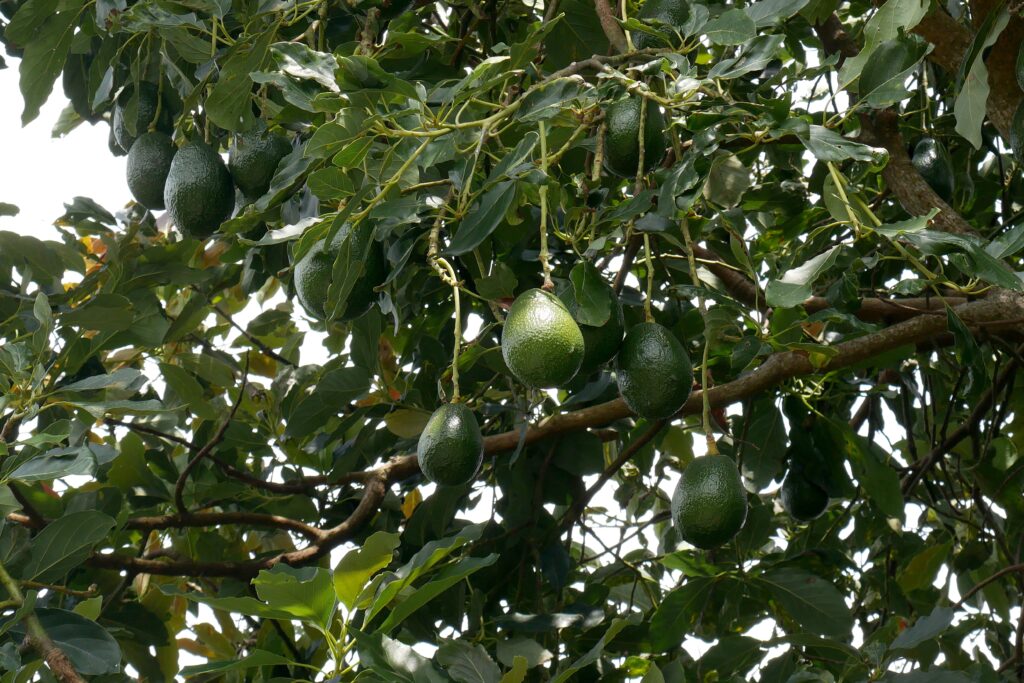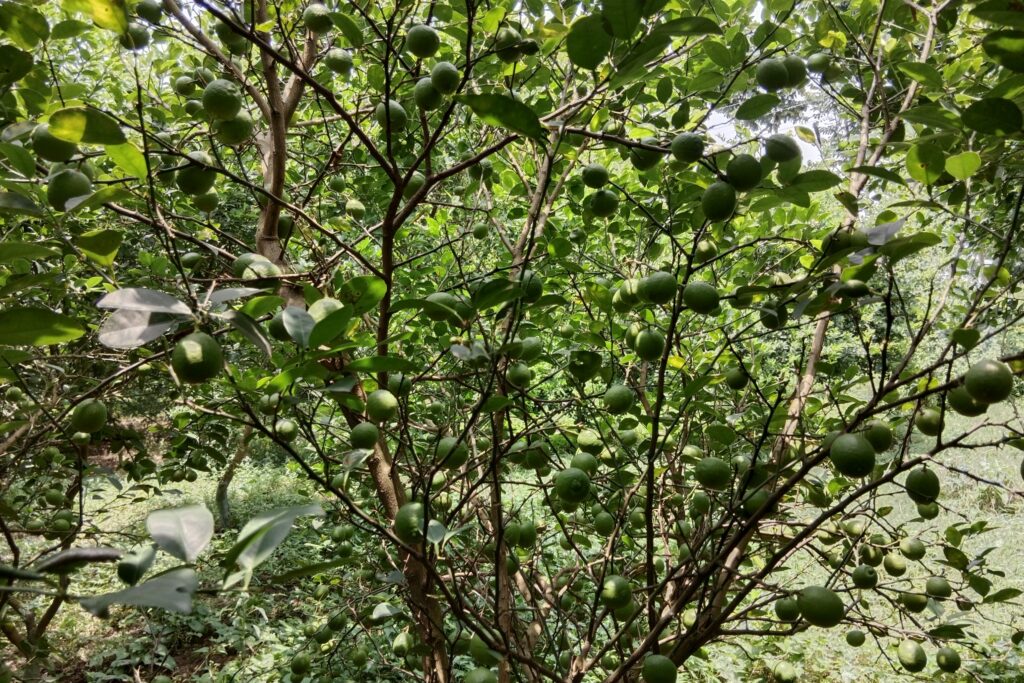Introduction
Avocado trees naturally drop unripe fruit to manage excess load, but this process can become excessive due to stress or pest pressure. While it’s common for trees to shed some fruit during the early stages of development to allocate resources efficiently. Excessive fruit drops can significantly reduce yield, indicating underlying problems that require attention. Avocados typically retain only around 1% of their initial flowers and fruit, meaning even small stress factors can have a large impact on the overall harvest. The causes of avocado fruit drop must know to control premature fruit drop.

One of the main contributors to early fruit drop is the hormone ethylene, which is produced at higher rates by fruitlets with defective seeds. These seeds, unable to develop properly, generate ethylene levels 7 to 10 times higher than normal, accelerating the dropping process. The seed is identified as the primary site of ethylene production, and this hormonal response can lead to mass shedding of unripe avocados, especially when seeds fail to develop normally due to fertilization issues.
In ‘Hass’ avocado trees, for example, a high percentage of flowers that eventually fall off were pollinated. However, pollen grains failed to germinate or produce pollen tubes, leading to a lack of fertilization and ovule deterioration. Premature fruit drops during early growth and June drop often stem from fertilization failures. Despite these challenges, avocados remain highly nutritious, rich in fiber, potassium, folic acid, and vitamin E, and are celebrated for their healthy oils that offer skin benefits and antioxidants.
5 Major Causes of Avocado Fruit Drop
Following causes may drop fruit in avocado:
Natural self-thinning
Avocado trees naturally shed young fruit because they often set more fruit than they can sustain, a process known as self-thinning. This is an essential mechanism for the tree to balance its carbohydrate supply, ensuring that only a few fruitlets mature into larger, healthy fruits. For instance, a single branch might produce over 40 fruitlets, but it cannot provide enough resources for all of them, leading to the natural shedding of the majority.
Avocado trees produce a massive number of flowers—up to a million per tree. However, not all flowers successfully set fruit. Some fall off due to unsuccessful fertilization, while others that were fertilized may also drop as part of the tree’s adjustment to its resource limits. This drop typically occurs in the first three to four weeks after flowering, followed by another phase in the summer when the fruit reaches a partial size.
A final fruit drop may occur in autumn, often triggered by environmental stress factors like insufficient water or high temperatures. This natural thinning ensures that the remaining fruits grow larger and healthier, supported by the tree’s limited resources.
Incomplete pollination
Avocado trees may drop fruit if it hasn’t been properly pollinated or fertilized. When you examine a dropped avocado, you might notice a dark-colored, aborted seed inside, indicating incomplete fertilization. Poor pollination can result from various factors, including unfavorable weather, lack of cross-pollination, or insufficient activity from pollinators, such as bees. This incomplete process leads to the tree shedding the undeveloped fruit.
Cross-pollination is often beneficial for avocados, with studies suggesting that cross-pollinated fruit has a higher chance of maturing fully. To enhance pollination, it’s recommended to encourage bee activity by planting pollinator-friendly plants near avocado trees and considering cross-pollination between different avocado varieties. By improving pollination practices, fruit retention, and overall yield can be increased.
Heat or Water stress
Young avocados are more prone to dropping from the tree when they experience stress, particularly when compared to older, larger fruit. While a certain level of fruit drop is normal for avocados, excessive loss can be linked to environmental stress. Water stress, either from under or overwatering, is a common cause of premature fruit drop. This is especially problematic during key stages like flowering and early fruit development, where consistent moisture levels are crucial for healthy fruit retention.
To minimize fruit drops and maximize yield, it’s important to avoid stressing the tree, particularly from heat and water-related issues. Providing consistent, well-drained irrigation can help maintain healthy trees and prevent excessive fruit loss. Keeping the tree properly hydrated, especially in hot weather, plays a key role in sustaining fruit development.
Boron Deficiency is the leading cause
Avocado trees are treasured for their creamy fruits and lush foliage, but ensuring optimal growth requires providing the right nutrients. Among these, boron plays a vital role in the tree’s growth and development. Along with nitrogen and zinc, boron is key to sustaining healthy fruit production. When trees are deficient in these nutrients, it can significantly impact fruit sets, leading to issues such as premature fruit drop. Regular soil tests and nutrient management can help mitigate these risks, ensuring the tree remains productive.
Symptoms of boron deficiency in avocado trees are critical to recognize for early intervention. Signs such as distorted growth, leaf discoloration, poor fruit quality, and fruit drop may indicate a lack of this essential micronutrient. These symptoms not only affect the overall appearance of the tree but can also lead to reduced yields. By addressing these deficiencies promptly, growers can improve fruit retention and quality.
Boron deficiency can cause various problems in avocado trees. Inadequate boron levels can result in flower abortion, poor fruit set, spongy stem tissue, premature fruit drop, and necrotic spots on fruits and seeds. Malformed fruits are another common issue associated with low boron levels, emphasizing the importance of maintaining balanced nutrition for the health and productivity of avocado trees.
Diseases and pests that cause fruit drop
Avocado trees are susceptible to several diseases and pests, which can lead to premature fruit drops. One of the most common diseases is root rot, which often results from overwatering and poor soil drainage. Another frequent issue is anthracnose, a fungal disease that specifically affects avocado fruit, causing it to drop before fully ripening. These diseases weaken the tree and disrupt its ability to retain fruit, leading to a significant reduction in yield.
Pests, such as avocado thrips and mites, can also play a major role in causing fruit drops. Avocado thrips feed on the fruit’s surface, leading to scarring and premature drops, while persea mites can cause more severe damage. Early signs of mite infestation include spotting and silvery webbing on the leaves, followed by leaf drops. If left untreated, these pests can lead to extreme conditions where fruit drops become inevitable. Regular tree monitoring and appropriate pest control measures, whether organic or chemical, are crucial for maintaining the health of the tree and preventing excessive fruit loss.
Preventive Measures to Control Avocado Fruit Drop
Followings are the preventive measures:
Consistent Irrigation
Maintaining appropriate irrigation is crucial to preventing avocado fruit drops since it keeps the tree from being overwatered or underwatered, particularly during critical growth periods. Mulching the area surrounding the base can help control temperature and hold onto soil moisture. Maintaining the soil at the ideal moisture level is essential to promoting good fruit development since excessively dry soil can stress the tree and cause an increase in fruit drops. Maintaining tree health and reducing fruit loss during rapid fruit growth requires balanced and consistent watering strategies.
Nutrient Management
Regular soil testing and the application of fertilizers rich in nitrogen, potassium, and micronutrients like zinc and boron are essential to reducing avocado fruit drops. Starch content in flowers is directly linked to their ability to develop into fruits, with flowers having higher starch levels being more likely to succeed. However, many avocado flowers have low starch reserves, which limits their chances of turning into mature fruits, contributing to reduced fruit sets and increased drop rates. Proper nutrient management can help address these challenges and support better fruit development.

Pest and Disease Control
Use integrated pest management (IPM) strategies to monitor and control pest populations. Fungicides and good cultural practices can help manage diseases that may cause fruit drops.
Pollination Enhancement
Understanding these causes and taking proactive measures can help minimize premature fruit drops and ensure a healthier, more productive avocado harvest. Regular tree care, proper irrigation, and nutrient management are key strategies to combat this issue and maintain optimal fruit production.


